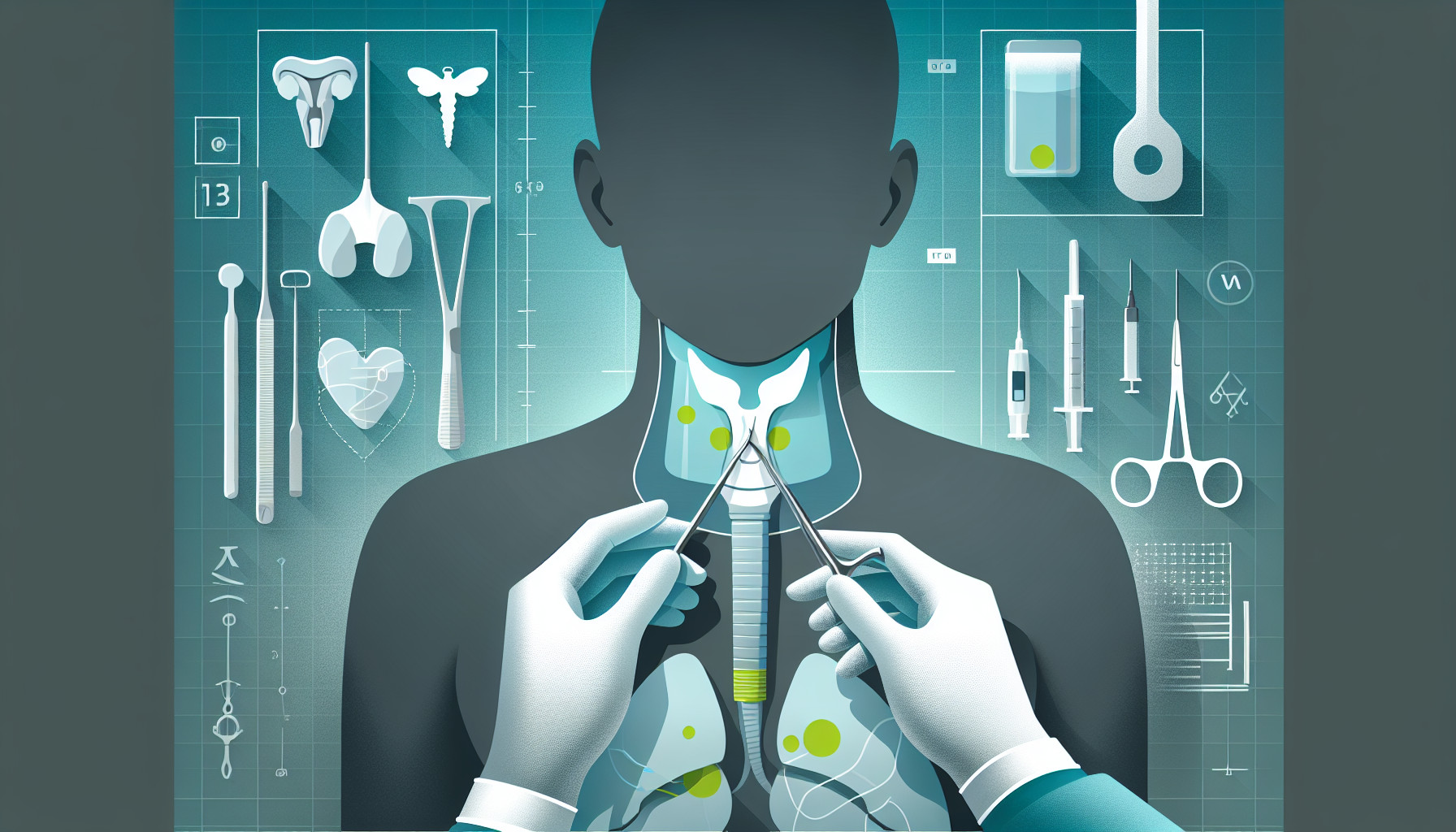Our Summary
This research paper is about a new surgical technique for removing the thyroid gland called transoral endoscopic thyroidectomy vestibular approach (TOETVA). This method is gaining popularity because it doesn’t leave a scar on the neck and is less invasive than traditional methods. The study was conducted in Erbil city, where 12 patients had this surgery between November 2020 and April 2021. The results showed no significant complications after surgery. However, it’s noted that TOETVA is a complex procedure that requires a high level of skill. Nonetheless, the technique shows promise for future use.
FAQs
- What is the transoral endoscopic thyroidectomy vestibular approach (TOETVA)?
- Why is the TOETVA method gaining popularity over traditional thyroidectomy methods?
- What were the results of the study conducted on TOETVA in Erbil city between November 2020 and April 2021?
Doctor’s Tip
One helpful tip a doctor might tell a patient about thyroidectomy is to follow all pre-operative instructions provided by your healthcare team. This may include fasting before surgery, stopping certain medications, and avoiding smoking. Following these instructions can help reduce the risk of complications during and after the procedure. Additionally, it’s important to discuss any concerns or questions with your healthcare team before undergoing thyroidectomy to ensure you have a clear understanding of the surgery and what to expect during recovery.
Suitable For
Patients who are typically recommended for thyroidectomy include those with:
Thyroid cancer: Patients with thyroid cancer may undergo thyroidectomy to remove the cancerous tissue and prevent further spread of the disease.
Benign thyroid nodules: Patients with large or symptomatic benign thyroid nodules may undergo thyroidectomy to alleviate symptoms such as difficulty swallowing or breathing.
Hyperthyroidism: Patients with hyperthyroidism, a condition in which the thyroid gland produces too much thyroid hormone, may undergo thyroidectomy to remove the overactive gland.
Graves’ disease: Patients with Graves’ disease, an autoimmune disorder that causes hyperthyroidism, may undergo thyroidectomy if other treatments are not effective or if there are complications.
Recurrent thyroid nodules: Patients with recurrent thyroid nodules that continue to grow or cause symptoms despite treatment may undergo thyroidectomy.
Thyroid nodules with suspicious or indeterminate biopsy results: Patients with thyroid nodules that have suspicious or indeterminate biopsy results may undergo thyroidectomy to further evaluate the tissue for cancer.
Overall, the decision to recommend thyroidectomy for a patient is based on factors such as the type of thyroid condition, the size and location of the thyroid nodules, the patient’s symptoms, and the risk of complications.
Timeline
Before thyroidectomy:
- Patient is diagnosed with a thyroid condition that requires surgical intervention.
- Patient undergoes pre-operative testing and evaluation to assess their overall health and determine the best course of treatment.
- Patient discusses the risks and benefits of thyroidectomy with their healthcare provider and makes the decision to undergo surgery.
- Patient receives instructions on how to prepare for the surgery, including fasting before the procedure.
After thyroidectomy:
- Patient is taken to the operating room and given anesthesia to induce sleep.
- Surgeon performs the thyroidectomy using the chosen surgical technique, such as TOETVA.
- Patient is monitored closely during and after the surgery for any complications.
- Patient wakes up in the recovery room and is closely monitored for any signs of pain, bleeding, or infection.
- Patient is discharged from the hospital once they are stable and able to care for themselves at home.
- Patient follows up with their healthcare provider for post-operative care, including monitoring thyroid hormone levels and managing any potential complications.
- Patient may experience temporary changes in their voice or difficulty swallowing as they recover from the surgery.
- Patient’s scar, if any, from the surgery begins to heal and fade over time.
- Patient may need to take thyroid hormone replacement medication for the rest of their life to manage their thyroid function.
What to Ask Your Doctor
- What are the potential risks and complications associated with TOETVA compared to traditional thyroidectomy methods?
- How experienced are you in performing TOETVA and what is your success rate with this technique?
- What is the recovery process like after TOETVA and how long is the recovery time compared to traditional thyroidectomy?
- Will I need to take any medications or follow any special dietary or lifestyle changes after undergoing TOETVA?
- How will my thyroid function be monitored post-surgery and what are the long-term implications of having my thyroid gland removed?
- Are there any specific criteria or conditions that would make me a better candidate for TOETVA compared to traditional thyroidectomy?
- How will my vocal cords be protected during the surgery and what is the likelihood of experiencing voice changes or vocal cord damage after TOETVA?
- Will I require any additional follow-up procedures or treatments after undergoing TOETVA?
- How will my hormone levels be managed after having my thyroid removed and what are the potential side effects of hormone replacement therapy?
- Are there any alternative treatment options to consider before deciding to undergo TOETVA for thyroid removal?
Reference
Authors: Jabbar SA, Alla Werdi NI. Journal: J Med Life. 2022 Oct;15(10):1283-1293. doi: 10.25122/jml-2021-0276. PMID: 36420298
